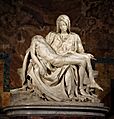Pietà (Michelangelo) facts for kids
Quick facts for kids La Madonna della PietàOur Lady of Piety |
|
|---|---|
 |
|
| Artist | Michelangelo Buonarroti |
| Year | 1498–1499 |
| Type | Marble |
| Subject | Jesus and Mary |
| Dimensions | 174 cm × 195 cm (68.5 in × 76.8 in) |
| Location | Saint Peter's Basilica, Vatican City |
| 41°54′8″N 12°27′12″E / 41.90222°N 12.45333°E | |
| Preceded by | Bacchus (Michelangelo) |
| Followed by | David (Michelangelo) |
The Madonna della Pietà (also known as La Pietà) is a famous marble sculpture. It was created by the Italian artist Michelangelo Buonarroti between 1498 and 1499. The statue shows Mary holding the dead body of Jesus after he was taken down from the cross. This sad moment is known as the "Sixth Sorrow" of the Blessed Virgin Mary.
You can find this amazing sculpture in Saint Peter's Basilica in Vatican City. It is a very important piece of Italian Renaissance sculpture. Many art experts believe it marks the start of the High Renaissance period. The Pietà combines the beauty of classical art with a natural look.
The statue was first ordered by a French cardinal named Jean Bilhères de Lagraulas. He was the French ambassador in Rome at the time. Michelangelo carved the sculpture from Carrara marble for the cardinal's funeral monument. Later, in the 1700s, it was moved to its current spot in the basilica. The Pietà is the only artwork Michelangelo ever signed.
In 1972, a man damaged the statue of Mary. After this, the Pietà was repaired. Now, it is protected by a strong bulletproof glass screen.
Contents
Mary's Youth in the Sculpture
In the Pietà, Mary looks much younger than her son, Jesus, who would have been about 33 years old. This was not unusual in art from that time showing the Passion of Christ. Artists often showed Mary as young to symbolize her pure and perfect nature.
Some people think Michelangelo was inspired by the writer Dante Alighieri and his famous poem, Divine Comedy. Michelangelo knew Dante's work very well. In one part of the poem, Saint Bernard of Clairvaux says to the Virgin Mary, "Virgin mother, daughter of your son." This idea might have influenced Michelangelo's choice to show Mary as youthful.
Michelangelo's Signature

After the Pietà was finished, it was placed in a chapel inside Saint Peter's. A story says that Michelangelo heard someone say another artist had made the sculpture. To prove it was his, Michelangelo carved his name onto the statue.
He carved these words on a sash across Mary's chest: MICHÆLANGELVS BONAROTVS FLORENTINVS FACIEBAT This means: "Michelangelo Buonarroti, the Florentine made this."
This was the only artwork Michelangelo ever signed. Some stories say he later regretted signing it out of pride. He then decided never to sign another one of his works.
A Trip to New York
In 1964, the Pietà left the Vatican for a special trip. It was loaned to the 1964 New York World's Fair in the United States. The statue was carefully packed in a strong wooden crate. This crate was designed to float and had an emergency beacon in case of an accident.
The Pietà traveled by ship on the Cristoforo Colombo. At the fair, thousands of people waited in long lines to see the sculpture. They moved past it on a special conveyor belt to get a quick look. After the fair, the Pietà was safely returned to the Vatican.
Protecting the Masterpiece
The Pietà has faced some damage over the years. In 1736, four fingers on Mary's left hand broke during a move. A sculptor named Giuseppe Lirioni repaired them.
Later, in 1972, a man with mental health issues attacked the statue with a hammer. He damaged Mary's face and arm. After this event, the Pietà was carefully restored. To protect it from future harm, it is now placed behind a thick, bulletproof glass screen. This allows visitors to admire the artwork safely.
Other Pietàs by Michelangelo
Michelangelo returned to the theme of the Pietà two more times in his life. However, he did not finish either of these later works.
- The Florentine Pietà (around 1547–1553) was likely meant for his own tomb. He worked on it for several years but then abandoned it. This one is sometimes called a Deposition, showing a moment just before the Pietà.
- The Rondanini Pietà was started in 1552. It was still very unfinished when Michelangelo died in 1564. He was working on it just six days before his death.
Images for kids
-
The grand pillars of the "Chapel of the Holy Choir", where the two Cherubic angels are relocated from the Pieta image since 1749. The Marian image is also Pontifically crowned by Pius IX (1854) and Pius X (1904), respectively. The Basilica of Saint Peter.
See also
 In Spanish: Piedad del Vaticano para niños
In Spanish: Piedad del Vaticano para niños
- Pietà
- Asteroid 274472 Pietà
- Replicas of Michelangelo's Pietà
- List of statues of Jesus
- List of works by Michelangelo
- List of Vatican City-related articles



